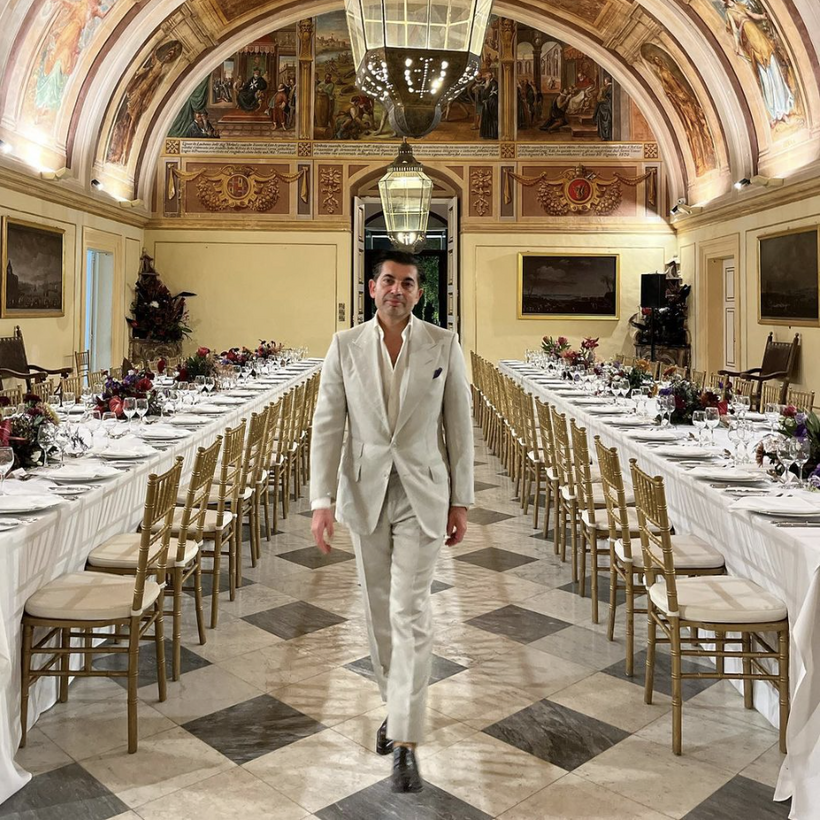Pinpointing Maltese-born, London-based interior designer Francis Sultana’s sense of style can prove elusive. Is it classic futurism, futuristic neoclassicism, or something else entirely?
“Either of those are quite a good way of putting it,” he says with a laugh, sitting on a striped sofa of his own design in the grand salon of his 16th-century Palazzo de Torres home in Valletta, Malta. A wildly abstract oil-and-gouache painting by Secundino Hernández hangs above his head.
After a meticulous restoration, Sultana has filled the home with important works of contemporary art, including a neon installation filling the stairwell by Jason Rhoades and sculpture by Eva Rothschild. Eccentric pieces by Paris-based artist Mattia Bonetti—including one of his otherworldly “Abyss” consoles, its swirling base slicked with glossy shades of red and gold—contrast with the capacious room’s double-height ceilings. (Those are the legacy of the palace’s ancient bones; it was originally built for one of the Knights of St. John.)

It’s all very Baroque ’n’ roll: Sultana’s talent is marrying the aesthetics of different eras (think Georgian meets Deco meets Egyptian) and layering in jewel-toned colors and decadent materials such as bronze, marble, rock crystal, and silk. He then ties it all together with striking, sculptural contemporary art. “It really gives an energy to things,” he says.
Alongside his own interior-design work, Sultana is also artistic director of his long-term partner David Gill’s eponymous contemporary-art gallery, in London. Sultana not only lives with art himself but appreciates the way of working it into a space to capture the personality of the homeowners. This approach has made him the serious collector’s go-to designer.

Yana Peel, Chanel’s global head of arts and culture, is among his happy clients. “So much of the spirit of Francis’s work comes down to his talent for bringing out the best in his collaborators,” she writes in the foreword to Sultana’s 2019 eponymous book. Most of Sultana’s interiors include at least one custom piece designed by Garouste & Bonetti, the Campana Brothers, or Fredrikson Stallard, all artists on Gill’s gallery roster.
Sultana is unapologetic about giving historic buildings contemporary face-lifts. “If I’m true to the past but bring it up to date and ensure it will be looked after for the future, then I feel much stronger putting a contemporary piece of furniture in it,” he says.
No longer the enfant terrible of his younger years, he says as he approaches 50, the projects are becoming more serious. He now owns a home in the Albany, the well-known Georgian apartment building off Piccadilly that once belonged to Flair founder and editor Fleur Cowles. He is also currently renovating John Fowler’s Hunting Lodge, in Hampshire, in collaboration with the U.K. National Trust.

Somehow, Sultana has ended up taking on yet another role, as ambassador of culture for Malta. In mid-October, Sultana traveled there to unveil the American artist Michele Oka Doner’s public sculpture The Palm Goddess for Malta. Eventually, this commission will live in the Malta International Contemporary Art Space (MICAS), but while the museum is still under construction, it sits in one of Valletta’s main squares for all to enjoy.
Next year will see the opening of Sultana’s first-ever hotel project, the re-invention of the Hotel La Palma, Capri’s oldest hotel, now owned by the Oetker Collection. Given Sultana has been visiting the island since he was 22 years old, the chance to bring the dusty but beloved Hotel La Palma back to life is a thrill. But there will be an international group of discerning regulars, afraid of its losing its charm, who will be assessing his every doorknob.

For Hotel La Palma’s look and feel, Sultana has loosened up a bit as a nod to Capri’s relaxed, holiday-centric sensibility, capturing the island’s “beautiful lightness, minimalism and flair.” But that doesn’t mean that he’s gone soft—the same aesthetic rigor that guides all of his projects still applies. The pleasure, he explains, comes from maintaining absolute control—“being in a space where I have designed almost everything,” he says, “from the taps to dining chairs. I have gone the whole way for this hotel.”
Fiona McCarthy is a London-based journalist and international contributing editor specializing in art and design. She is a regular contributor to Elle Decoration UK, Vogue Living Australia, and The Times of London, and a co-author of interior decorator Kit Kemp’s best-selling interiors titles, including Design Thread


